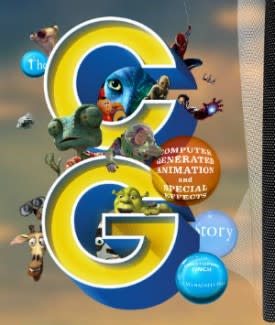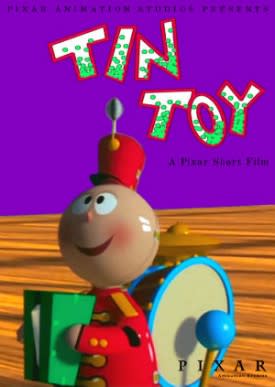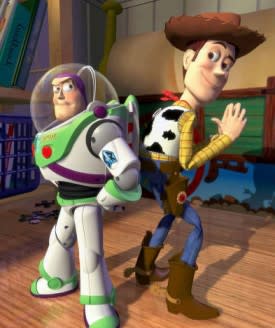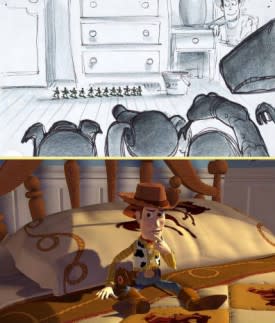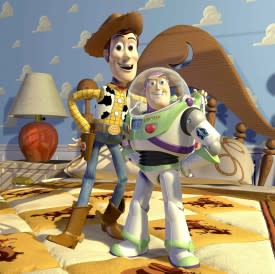Exclusive Book Excerpt: ‘The CG Story’: How Pixar Saved ‘Toy Story’ From Becoming A Disney Disaster
The history of special effects and CG in film and their close relationship with today’s top-notch digital animation is the focus of author Christopher Finch’s new lavish 368-page book The CG Story: Computer Generated Animation and Special Effects, which peels the curtain back on CG pioneers like George Lucas, Steven Spielberg, Ridley Scott, and Pixar founders John Lasseter and Ed Catmull and their respective contributions to film. As part of Deadline’s weekend programming, read an exclusive excerpt from The CG Story, available now via The Monacelli Press (large format hardcover, $75), detailing the near-disaster that almost was when the upstarts at Pixar pacted with Disney to make their first feature: Toy Story.
Go motion may have been extinct overnight, as if by a meteor bombardment, but Phil Tippet reinvented himself as the head of a CG studio, and many of his go-motion animators were quick to retrain as CG animators, adapting their old skills with relative ease to the new way of working. During the early 1990s the shift to computer-generated animation was seen as a matter of urgency in many sections of the industry. Technologies such as motion control remained in use where they were cost effective, but this was the period when CGI began to take on the dominant role in visual effects. In the world of pure animation, it was about to make its mark with even greater decisiveness.
Ed Catmull explains that at Pixar there was a plan to progress from making commercials to producing a television special and then eventually a feature film. Having developed the CAPS system for Disney, Pixar had extensive contact with the feature-animation department there, but in fact they shopped their ideas around to everyone but Disney. One bone of contention was the fact that Disney had made efforts to hire John Lasseter away from the company. Jeffrey Katzenberg, then Disney studio head, had been impressed by the shorts he had seen and was convinced that Lasseter, by then Pixar’s creative director, was the secret to the company’s success. Lasseter, however, turned down the offers because of his belief in Pixar’s future, and because of his bitter memories of his previous tenure at Disney. Those memories were also why he had been adamant about not wanting to take ideas to Disney. “It wasn’t until [then],” Catmull remembers, “that I found out the real problem. For years he wouldn’t let anybody know he’d been fired… On the Queen Mary he had acknowledged that his project had been turned down, but not that he had been fired.”
The fact that Disney now saw Lasseter as a golden boy did nothing to alter his point of view, but finally, after no other studio had taken the bait, Pixar had no alternative but to consider working with Disney. The initial approach, in fact, came from Disney. In 1991 Catmull received a call from Peter Schneider, president of Feature Animation, suggesting that Pixar make a CG feature that Disney would finance and distribute. It should be remembered that Disney’s animation renaissance was in full bloom at the time — Aladdin would shortly be released and The Lion King was in preproduction. Disney Feature Animation had always been a strictly in-house operation, and the idea of turning to an outside production studio, especially in those glory days, was shocking. Lasseter believes it was Tim Burton and Henry Selick’s stop-motion movie The Nightmare Before Christmas (1993) — acquired for distribution by Disney’s Touchstone Pictures — that had cracked the door open. Coincidentally, as noted earlier, Burton and Selick had been contemporaries of Lasseter at CalArts, and Burton had also been at Disney as an animator during Lasseter’s ill-fated stay there in the 1980s. It was, however, Burton’s success with live-action films like Beetlejuice (1988) and Batman (1989) that had made him a box-office icon and had convinced Disney to take on the distribution of Nightmare. Lasseter suggests that Michael Eisner and Jeffrey Katzenberg, then at the studio’s helm, saw CG animation as something that, like stop motion, might find a niche audience.
The deal entered into by Pixar was provisionally for three features, but everything was contingent on the first being a success, and that was a tall order. Nobody had ever made a wholly animated CG feature, and nobody on the Pixar team had any experience of feature-film production in any capacity other than technical input for brief visual-effects scenes. It was much like the situation in which Walt Disney found himself in 1934 when he committed to making Snow White and the Seven Dwarfs. If anything, Pixar’s task was even more intimidating. When Disney launched his feature-film career, he had already created a world-famous cartoon character and had made scores of innovative and commercially successful short cartoons. Pixar had produced four very short shorts and a handful of commercials. The challenge was akin to attempt¬ing to swim the English Channel having trained in a backyard swimming pool.
Central to this challenge was coming up with a story that could carry a feature-length movie. The core creative team initially consisted of Lasseter, who would direct the as-yet-unnamed film, and the two newcomers, Andrew Stanton and Pete Docter, whose experience was, to put it mildly, minimal. Luckily, the ideal person to complete the team was just across the bay in San Francisco, at Skellington Studios, where he had been working as storyboard supervisor on The Nightmare Before Christmas.
Often described by his contemporaries as a gentle giant, Joe Ranft had attended CalArts at the same time as Lasseter and like Lasseter had been recruited by Disney, where he worked as an assistant animator on The Fox and the Hound (1981), as a con¬cept artist on The Black Cauldron (1985), as a story-board artist on Basil of Baker Street (1986), and as story supervisor on The Rescuers Down Under (1990). Among storyboard artists and gag men Ranft had few peers. He was the kind of draftsman who could convey the essence of an idea with a few quickly sketched lines, then develop it with the succinct thoroughness that is the marrow of animated films. As a story supervisor he had the ability to oversee the artists on his team with firmness, humor, and an intuitive sense of tact. It was small wonder that Tim Burton had invited him to take charge of the storyboards for Nightmare.
While they were both at Disney, Ranft had helped Lasseter develop the story ideas for The Brave Little Toaster, and the two had remained friends. Now they found themselves practically neighbors in Redwood City, south of San Francisco on the fringe of Silicon Valley. Inevitably Ranft visited Pixar, where he became involved in early discussions about a proposed Christmas television special that would have expanded on the ideas and characters in Tin Toy. When the Toy Story project was launched, Ranft was still engaged on Nightmare, but from the outset he met regularly with Lasseter, Stanton, and Docter on his days off and whenever else he could, intending to join Pixar when his work at Skellington was complete.
After a few months, Ranft became a full-time member of the core group — dubbed the Brain Trust — bringing to it his own offbeat brilliance and the one thing it was missing: experience with the processes and vicissitudes of producing feature animation.
John Lasseter has said that the first thing they did when they began thinking about Toy Story was to make a list of things that they did not want to be in it. Foremost among these was anything that resembled the ingredients of Disney movies of the period. Pixar would not attempt to top The Little Mermaid or Beauty and the Beast. There would be no soaring musical numbers, no larger-than-life caricature villains, no cute comic-relief animals. The Toy Story Brain Trust had grown up with movies, television situation comedies, and action shows rather than Broadway extravaganzas. They decided to make a buddy picture, “along the lines,” says Lasseter, “of The Odd Couple and Midnight Run.”
Their point of departure was still Tin Toy, and the key setting would be a child’s playroom, so a buddy for Tinny had to be found. The initial idea was to pair him with a ventriloquist’s dummy. It didn’t take long, however, to see that such old-fashioned toys would be very hard to endow with the kind of personalities that would keep audiences glued to their seats for an hour and a half. Tinny and the ventriloquist’s dummy were consigned to the archives, and a new search for an unlikely pair of buddies was launched.
An action figure of some sort seemed to be a logical choice, but it took some time for the Brain Trust to settle on the idea of an astronaut with an almost psychotic sense of mission and self-worth. And so Buzz Lightyear, Space Ranger, came into being and was given a reluctant buddy in the form of Sheriff Woody, a pull-string rag doll souvenir of an imaginary early black-and-white television series. They would prove to be superb choices, but there would be a long period of growing pains before they evolved their final, satisfyingly interlocking personalities.
The first few months of development were a period of noisy to-and-fro discussion — sometimes raucously funny, sometimes argumentative — around a table littered with a Toys “R” Us–like inventory consisting of action figures, dinosaurs, Slinky Dogs, G.I. Joes, and Mr. Potato Heads, some of whom would be reborn as characters in the movie. Here were four grown men feeling their way back to childhood, but there was one rule in place that was distinctly adult. There would be no complacency. Nobody’s ideas were immune to criticism. On the contrary, every effort should be made to shoot holes in each other’s ideas, however sound they might seem on first inspection. This was in fact more than a rule, it was a creed, and the license to criticize, combined with the ability to take criticism, became a strong bond between the members of the Brain Trust. Not that this way of working was always easy. As someone who does his writing alone, seated in front of a computer, I once told Pete Docter that I envied his situation of developing a story in a group situation. He laughed and said, “You should try it sometime. It can be brutal.”
Brutal maybe, but enormously effective. It was this Pixar creed that would make Toy Story work so well, and it would stand the company in good stead for the movies that followed. For the moment, though, Lasseter and the others could not look beyond their first feature, knowing that unless it was a success it would probably be the only one they would ever get to make.
Even though the deal was in place, there was still some skepticism surrounding the project at Disney, both in Feature Animation and in the brand-new Michael Graves–designed Team Disney Building, where top executives fretted about grosses behind a fascia that prominently featured larger-than-life replicas of the Seven Dwarfs. Despite the symbolism of this playful architectural motif, there was concern that a film set in a small boy’s playroom would not have any appeal for key segments of what was perceived as the target market — teenagers, for example. A movie about toys would be just a kids’ movie. Lasseter felt that this point of view was completely misguided.
“When Andy, the kid, goes to sleep, the toys come to life, and they behave like adults. . . . They have personalities that adults can identify with. We were making a film that was a movie that we would want to see, and we’re adults. We wanted to capture a children’s world too, but we felt we were aiming for a very broad audience.” To placate the doubters, it was decided that a short reel of completed animation should be prepared, to demonstrate the viability of the relationship between Buzz and Woody.
By this juncture the two characters had taken on something close to their final form. This involved many processes, as is the case with all CG animated characters. First comes work by character designers and concept artists. Lasseter gives credit for Woody’s appearance to veteran animator, cartoonist, illustrator, commercials director, musician, and voice talent (Rick Dicker in The Incredibles, Eeyore in Disney’s Winnie the Pooh) Bud Luckey, who had the idea of pairing Buzz with a cowboy and who produced key concept drawings (p. 84). After character design comes the preparation of fully volumetric models. These begin life as wireframes that can be generated entirely in the computer, though at Pixar it is also commonplace to have fully detailed clay, plaster, or resin sculptures of characters prepared that can be measured and translated into the database.
The basic wireframe model, once it meets the director’s approval, is then ready to be “rigged,” which means that it is outfitted with a digital skeleton, digital musculature, and even a digital nervous system. This allows the animator to manipulate the figure electronically, much as a puppeteer manipulates a marionette by means of strings attached to control bars. Pixar in fact uses proprietary software dubbed Marionette for precisely this purpose.
For characters in a film such as Toy Story, there is a hierarchy of layers of rigging, ranging from those that control broader motor functions (turning the head, bending a knee), to those that handle finer motor skills (crooking a finger), and finally delicate rigging used to produce the almost imperceptible motions that help change a character’s facial expressions (narrowing the eyes, teasing the corners of the lips). Repetitious ana¬tomical functions such as running can be programmed, and it’s even possible to program tics, so that, for example, a character might blink according to some randomized pattern without the animator having to think about it.
An advantage that CG animation has over hand-drawn animation is that working with rigged models guarantees a degree of consistency, whoever is animating the character. With hand-drawn animation, characters can change significantly when drawn by two different animators, even if both are equally skilled draftsmen. What remains the same in both techniques is the need for acting ability on the part of the animator.
The character’s virtual skeleton — which, of course, is not visible, even at the wireframe stage — is used to determine the position of key points scattered around the model, densely in some areas, less so in others. These are properly called animation variables but usually are referred to as “avars.” They correspond to the “markers” employed when using motion-capture technology, which, when scanned into the database, effectively become avars. Avars mark the control points at which the virtual strings of Pixar’s Marionette software “tug” at the digital model in the database and permit the animator to bring the character to life. Woody was supplied with over seven hundred, of which more than a hundred were needed for his face, fifty-eight of them for his mouth alone.
To complete the Woody model, it had to be clad, both with a skin and with clothing. The wireframe model becomes a kind of armature, to which the illusion of a skin is digitally applied and detail added until the final likeness of the character begins to materialize. (The basic process is analogous to the way a “stretch-wrap” metal cladding is applied to a sculptural building such as Frank Gehry’s Walt Disney Concert Hall, in Los Angeles, which features randomly contoured, organic intersecting forms generated by means of computer simulations.) In the final phases, the textures of clothing are mapped and rendered, so that a hat appears to be made of felt, a shirt of cotton, and boots of imitation leather.
Even before the model is completed, the director and his closest collaborators will have discussed the question of voice talent. In the case of Woody, Lasseter knew from the outset that he wanted Tom Hanks. Instead of approaching the star cold, Pixar created footage of Woody animated to dialogue spoken by Hanks in Turner and Hooch. That convinced Hanks to commit to the movie. For Buzz Lightyear, Lasseter had hoped for Billy Crystal, but Crystal passed on the project. Instead, Lasseter turned to Tim Allen, which proved to be a smart move. Hanks and Allen recorded some dialogue, which was animated and fully rendered and shown to the Disney bosses, who were impressed. Doubts about Pixar’s ability to make a feature-length film were shelved — for the moment.
While the Buzz and Woody test seems to have satisfied Disney executives about Pixar’s technical capabilities, they were not so sanguine about the way the story was developing. The key figures at Disney, so far as Toy Story was concerned, were Jeffrey Katzenberg, Peter Schneider, and Tom Schumacher. Before coming to Disney, Katzenberg had been at Paramount, where he had helped revive the Star Trek franchise. Schneider and Schumacher — then Schneider’s number two — had backgrounds in the theater (and would go on to supervise the creation of Disney’s successful theater franchise on Broadway and around the world). All three had learned most of what they knew about animation while on the job at Disney Feature Animation. They had overseen the Disney animation renaissance, which, as noted by Lasseter, was rooted in the traditions of American musical comedy in both its stage and cinematic guises, and in the tradition of the early Disney features, which were essentially animated musical comedies. The storyboards and animatics that were coming from Pixar had something very different to offer, and it threw the Disney executives off balance.
Even the way the Pixar team presented their work was different. They prepared their animatics — animated storyboards — in video form on Avid nonlinear editing machines, by far the most logical and inexpensive way of achieving the results they were after. They intended to show these to Disney in video but were informed that they had to be presented on 35 millimeter film stock, apparently because that was the way things had been done for as long as anyone could remember.* This lasted, says Ed Catmull, until Katzenberg accidently happened to see an animatic running on an Avid. The next day he bought five Avids.
That was one small victory, but still the Disney team didn’t quite understand what the Pixar movie was aiming at. Katzenberg was convinced, according to Lasseter, that it lacked “edginess,” a word he used repeatedly that was picked up by his subordinates. The Pixar group found itself taking notes from three levels of executives, all of which they were expected to act upon or else explain why they hadn’t. It was a frustrating way to work, and it began to have an effect on how the Pixar team thought about the story and the characters. “They wanted edgy,” says Lasseter, “and that’s what we tried to give them, with the result that Buzz and Woody began to seem mean-spirited, or worse.”
The idea of making an animated buddy movie was a good one, but buddy movies call for a delicate balance. It’s a given that the protagonists start out by getting on one another’s nerves, but if that is pushed too far and descends into ugly personal attacks, then it will be difficult if not impossible to make the characters sympathetic and to resolve the relationship satisfactorily later in the film. Ugliness was beginning to insinuate itself into the relationship between Buzz and Woody, but the Brain Trust didn’t quite realize it. They had set out to make their own movie, but the present opportunity was far too important to sabotage through arrogance, and so they forced themselves to accommodate the barrage of frequently misguided criticism emanating from Burbank.
Another problem, in Catmull’s estimation, was that Disney tended to see the project as belonging to Lasseter, who after all was the director and the creative star — the man who had convinced them that the movie could be made. As an old Disney hand with some solid credits to his name, Joe Ranft carried some weight too, but Disney utterly failed to understand the way that Pixar functioned as an entity, the creative team working in step with the technical team, which had an equal right to be thought of as a generative force.
November 17, 1993, is a date that among Pixar veterans ranks alongside Pearl Harbor Day. That morning Lasseter, Ranft, Stanton, and Docter reported to the Disney Feature Animation Building, where they screened a substantial section of their work in progress for Katzenberg, Schneider, Schumacher, and a small entourage of executives. The screening was met with dismay verging on horror, and the Pixar team was told that the film was a disaster.
To make things worse, Lasseter and his colleagues agreed. Seeing their work under these circumstances, they woke up to the fact that they had gone badly off track. Lasseter freely admits to being embarrassed by what he saw on-screen that day. Trying to make the characters edgy, they had made them repellent.
For Lasseter, this was a personal disaster, bringing back ugly memories of what had happened to him at Disney ten years earlier, when he had presented his Where the Wild Things Are test and pitched the idea for The Brave Little Toaster. History seemed about to repeat itself when Peter Schneider ordered an immediate shutdown of the production, pending a script rewrite that would involve bringing in writers of Disney’s choice. If that rewrite was accepted, then the production would resume, but in Burbank, and under close supervision. In short, control would be taken away from Pixar, who would supply little more than the basic story idea and their CG expertise.
Katzenberg, meanwhile, had taken Tom Schumacher aside and asked him what had gone wrong. Schumacher, sympathetic toward Lasseter and his crew, told him that Disney had taken the movie away from Pixar by butting in too much.
It was crunch time. Lasseter was determined not to give in without a fight and asked for two weeks to turn the project around. Without enthusiasm, the Disney brass acquiesced, perhaps because those two weeks would include the Thanksgiving holi¬day period, so that not much time would be lost. The Brain Trust returned to Point Richmond and worked around the clock with newly hired editor Lee Unkrich added to the mix, fiercely revising the story to get it back to the movie that they had wanted to make in the first place. Pete Docter recalls that Joe Ranft’s contribution was critical at this stage, because he had been through the grinder before, and — perhaps for that reason — because he was not afraid to take risks, expressing himself with an emotional intensity that inspired the others.
The key shift was to make Woody a more sympathetic character. Buzz needed less work, since his pompous sense of self-worth was indispensable to the narrative (he does not even realize he is a toy). In what could be seen as a response to Disney’s concerns about the film being too much of a kid’s movie, there was a major rewrite of a scene in which the toys in Andy’s room have a kind of town-hall meeting to discuss the situation between Buzz and Woody. In the version presented to Disney on November 17, this had the air of a bunch of children prattling in the playground, but now it took on the tone of an adult debate.
At the end of the two weeks the Pixar team returned to Burbank and made their presentation to an initially skeptical group of Disney executives, who were astonished and quickly won over by the thoroughness of the turnaround. The production was reinstated. Disney continued to send notes and insisted on adding experienced screenwriters to the story team, selecting Joel Cohen, Alec Sokolow, and Joss Whedon, ace script doctor, creator of Buffy the Vampire Slayer, and future director of The Avengers (2012). Happily, these additions meshed well with the existing members of the team, who, after their traumatic experience, knew how to deal with notes without being trapped into betraying their vision.
The film that was eventually premiered on November 19, 1995 — two years almost to the day after the disastrous presentation to the Disney executives — was brilliantly original in several different ways. Under Lasseter’s direction Pixar had fashioned a film that would have been a breakthrough even if it had been made as a conventional 2D animated feature. This was not a cartoon, or a fantasy with palaces and princesses, or even a stylized situation comedy with an exotic or period setting like Lady and the Tramp or The Aristocats. There were no larger-than-life good guys and bad guys. Toy Story was a buddy movie set in an everyday American suburbia, inhabited by realistic characters like Andy, the boy who cherishes Woody and Buzz and the other toys, and Sid, the not-so-nice kid next door (p. 90). It was a film where the human characters ate at fast-food outlets with names like Pizza Planet, and the cars in the movie’s parking lot were just like the actual cars parked outside the movie theater. The almost magical ordinariness of the animated human environment made it possible to believe in the toys and the ways in which they interacted with that environment.
That magic and believability depended in equal parts on the imaginations of the story team and on the creative achievements of the technical team, which quite simply blew audiences away. No one had experienced anything like it before. This was a world that was alive and, in Lasseter’s words, possessed “a sense of history. So the doors are banged up, the floors are scuffed.” The characters who moved through this world were as “solid” as actors in a live-action movie, and the sets were as three-dimensional as the sets for a live-action movie. Wood looked like wood, plastic looked like plastic, metal looked like metal and, even more remarkably, hair looked like hair. The virtual camera movements were stunning and had the ability to give theatergoers a toy’s-eye view of the world.
From a technical point of view, the story that so captivated audiences came wrapped in a crazy quilt of interlocking algorithms. It had taken eight hundred thousand computer hours to complete this film, and 114,240 frames of animation, with some individual frames requiring as many as fifteen hours to render, but finally Ed Catmull’s dream had come true. He and his collaborators had created the means to produce a computer-generated animated feature film. It was a triumph artistically and an enormous box-office hit. The world of animation had changed forever.
Related stories
Pixar’s John Lasseter Touts Traditional Animation at AMPAS Event
Pixar Sets 3 Original Toons; Disney Confirms ‘Muppets 2′: CinemaCon
Get more from Deadline.com: Follow us on Twitter, Facebook, Newsletter
